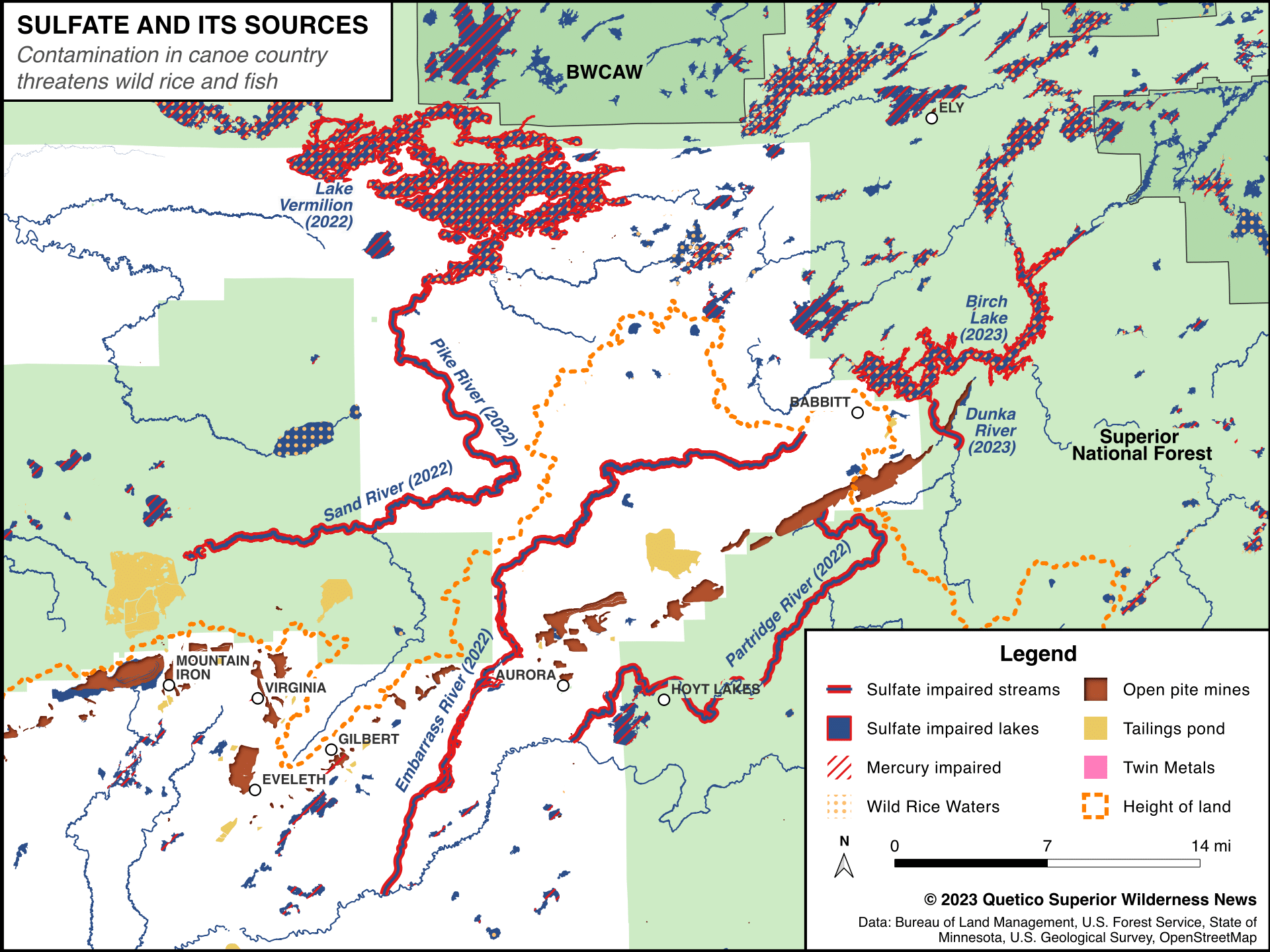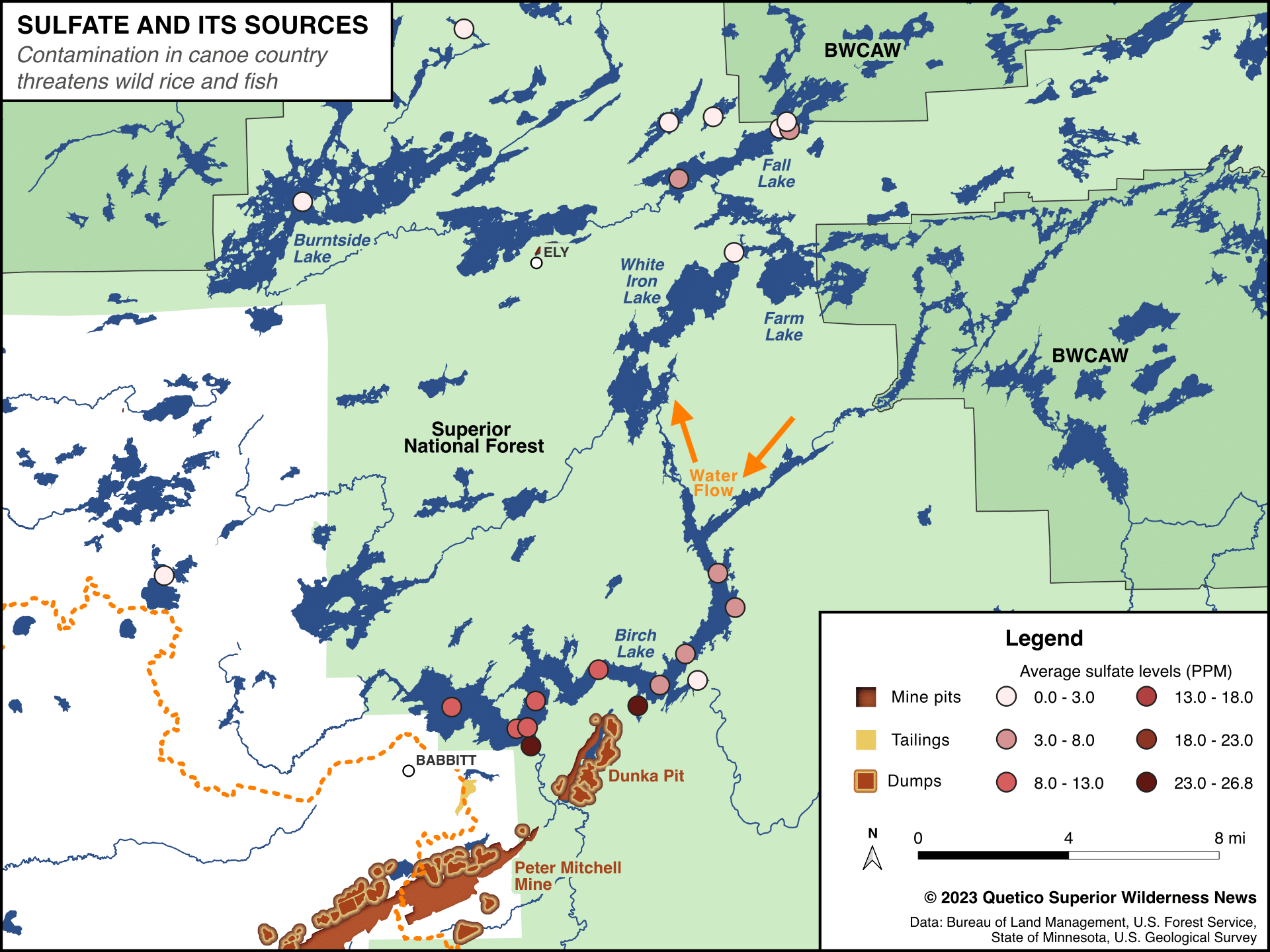
MPCA: High levels of problematic pollutant found in Birch Lake upstream from BWCAW
Several lakes and rivers upstream of the Boundary Waters Canoe Area Wilderness are contaminated with sulfate, which causes more mercury in fish and kills manoomin (wild rice), according to the Minnesota Pollution Control Agency and several citizen-led sampling efforts. In the past two years, the agency has considered new data that shows how waters downstream of past and present iron mines exceed standards for sulfate levels designed to protect the environment.
Notably, the MPCA recently announced that Birch Lake has excessive sulfate in its water. While advocates have long pushed for its designation, during the last round of review, the MPCA said it did not have enough data to make the determination. Environmental groups and scientists got to work.
Listing a waterbody as “impaired” means the federal Environmental Protection Agency will oversee remediation efforts. Birch Lake is also where Chilean mining company Antofagasta PLC, through its subsidiary Twin Metals Minnesota, has proposed to construct a new copper-nickel mine. Mine waste stored on the edge of the lake could increase the amount of sulfate flowing into the lake.
Point of pollution
According to a volunteer who has collected data on sulfate levels in the area, the high levels recently observed in the Dunka River can be traced back to one mine, and a decision seven years ago by the Minnesota Department of Natural Resources. Eric Morrison has a PhD in chemistry and is involved with a group called the Northern Lakes Scientific Advisory Panel, which provided data to the MPCA. He says mine waste flowing into Langley Creek from the Northshore taconite mine is correlated to increasing sulfate. Langley ultimately joins the Dunka River, newly listed as impaired, which flows into Birch Lake.
“In 2014, the DNR gave permission to Cliffs Erie for mine expansion at Northshore, which included allowing waste water discharge into Langley Creek which flows into the Dunka,” Morrison says. “Since October 2015, sulfate concentrations in Langley have increased from less than three ppm to 70 ppm and by October 2020, five tons of sulfate were flowing from the Dunka River into Birch Lake each day.”
Morrison and the NLSAP’s work has previously helped demonstrate that Lake Vermilion is also degraded by sulfate, which primarily comes from the Pike River — and the Minntac iron mine that discharges wastewater into its headwaters. Vermilion and those tributaries were listed as impaired for sulfate in 2022.

Citizen science
The work on Birch Lake and downstream of the Northshore mine correlates with the findings of another study led by Northeastern Minnesotans for Wilderness and the Campaign to Save the Boundary Waters. The organization also conducted extensive water quality data collection from Birch Lake in the past few years to support listing the lake as impaired, providing the majority of the data the MPCA used.
“It has long been known that there is sulfate pollution in Birch Lake, but so far effectively nothing has been done to address it,” said Lisa Pugh, Water Quality Monitoring Program Manager at NMW and Save the Boundary Waters. “In 2021, we rapidly expanded our water quality testing program after discovering that the state had in its possession almost no data on sulfate concentrations in the west end of Birch Lake, where mining pollution is discharged.”
NMW collected dozens of samples from Birch Lake, which were tested in a laboratory in Hibbing and added to the state’s database of water quality. The data showed consistently elevated levels, especially in the bays where the Dunka River and other streams enter from mining areas.
Meanwhile, NLSAP has sampled lakes all the way downstream to Crooked Lake, on the Canadian border, finding elevated levels the whole way. While lakes that are not downstream of Birch have sulfate levels of about 1.5 ppm, Morrison says that Crooked Lake has about 2.5 ppm. Birch Lake comes in at 4.5 ppm. Langley Creek, flowing out of the Northshore Mine, sees the highest levels — about 50 ppm.

Elevated and increasing
The legal limit for sulfate in Minnesota waters where manoomin grows is 10 ppm, but Morrison says the natural level for any of these cold, clear lakes is less than 2 ppm. Levels are already elevated, and will continue to increase until something is done to reduce sulfate releases from mine sites.
Currently, one ton of sulfate leaves Birch Lake everyday, flowing down the South Kawishiwi River through White Iron and other lakes, and ultimately into the Boundary Waters, Morrison says. With manoomin growing in Birch Lake and several of those downstream, which are also popular for fishing, the sulfate could have serious effects on people and the larger ecosystem.
“The data reveal the serious mining pollution flowing into Birch Lake every day, and made the MPCA’s listing of Birch Lake as a wild rice water impaired for sulfate the correct and unavoidable decision,” stated Matt Norton, Director of Science and Policy at NMW and Save the Boundary Waters.
Sulfate is a relatively benign substance that can cause a cascade of impacts throughout the ecosystem. When it enters sediment on lake bottoms where manoomin grows, it reacts with other compounds to weaken and eventually kill the wild rice. Many lakes in the area are also already polluted with mercury, much of it deposited from the atmosphere. But the mercury is a minor problem unless it is “mobilized,” converted into a form that can be consumed by animals. Sulfate is a key ingredient to converting mercury into this form, and leads to more mercury in fish, which can then contaminate people who eat it — causing neurological and other problems.
Boundary Waters worries
Now that Birch is officially impaired, Morrison believes it is only a matter of time until the pollution flowing downstream raises sulfate levels in other sensitive lakes, including inside the Boundary Waters.
“There is no doubt that lakes and rivers downstream from Birch Lake in the BWCA are polluted with sulfate all the way to Lower Basswood Falls and Crooked Lake,” he says. “When the sulfate in Birch doubles, mercury methylation and mercury contamination of fish will increase dramatically in BWCA lakes that are downstream.”
That state’s list of impaired waters is updated every two years. A draft for next year’s changes was released on Nov. 14. Public comments are currently being accepted through Jan. 12, 2024, with several public meetings scheduled in December. After the list is finalized next year, it will need to receive approval from the Environmental Protection Agency. The final list should be approved next April.
“The listing of Birch Lake means that the machinery of the Clean Water Act will begin to turn, requiring — we hope — cleanup of the mining pollution still being dumped into the lake,” said Lisa Pugh of NMW and Save the Boundary Waters.
More information:
- Minnesota’s impaired waters list – Minnesota Pollution Control Agency
- MPCA: Birch Lake impaired from sulfate discharges – Timberjay
- Popular lake near the Boundary Waters recognized as impaired for sulfate by the Minnesota Pollution Control Agency – Campaign to Save the Boundary Waters

